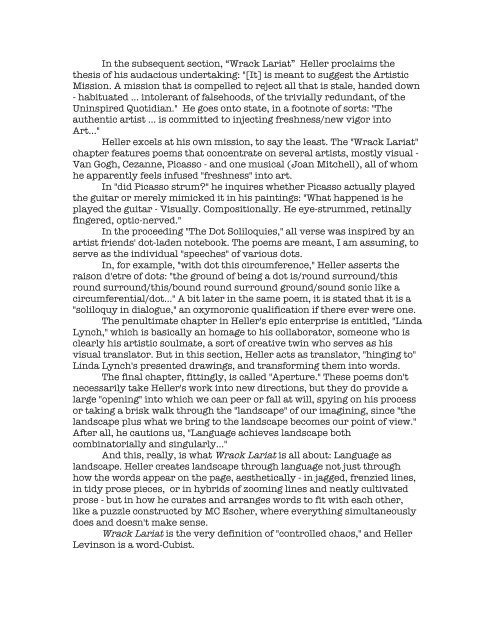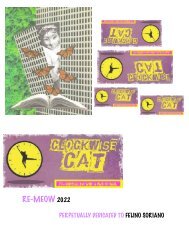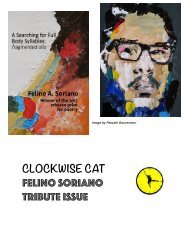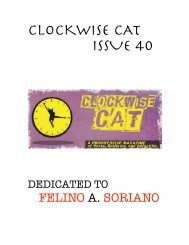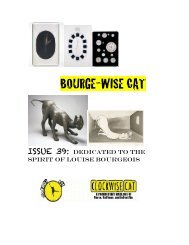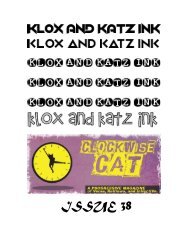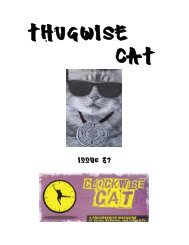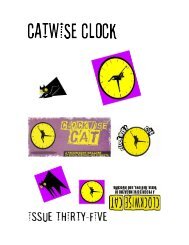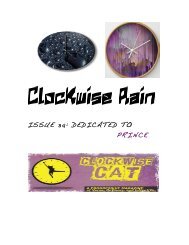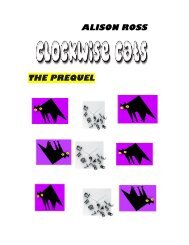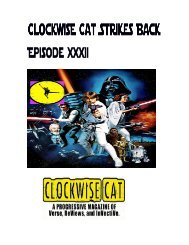StarCat/CatStar
StarCat/CatStar is dedicated to the memory of David Bowie, that cosmic subversive who’s returned at last to his ethereal home.
StarCat/CatStar is dedicated to the memory of David Bowie, that cosmic subversive who’s returned at last to his ethereal home.
You also want an ePaper? Increase the reach of your titles
YUMPU automatically turns print PDFs into web optimized ePapers that Google loves.
In the subsequent section, “Wrack Lariat” Heller proclaims the<br />
thesis of his audacious undertaking: "[It] is meant to suggest the Artistic<br />
Mission. A mission that is compelled to reject all that is stale, handed down<br />
- habituated ... intolerant of falsehoods, of the trivially redundant, of the<br />
Uninspired Quotidian." He goes onto state, in a footnote of sorts: "The<br />
authentic artist ... is committed to injecting freshness/new vigor into<br />
Art..."<br />
Heller excels at his own mission, to say the least. The "Wrack Lariat"<br />
chapter features poems that concentrate on several artists, mostly visual -<br />
Van Gogh, Cezanne, Picasso - and one musical (Joan Mitchell), all of whom<br />
he apparently feels infused "freshness" into art.<br />
In "did Picasso strum?" he inquires whether Picasso actually played<br />
the guitar or merely mimicked it in his paintings: "What happened is he<br />
played the guitar - Visually. Compositionally. He eye-strummed, retinally<br />
fingered, optic-nerved."<br />
In the proceeding "The Dot Soliloquies," all verse was inspired by an<br />
artist friends' dot-laden notebook. The poems are meant, I am assuming, to<br />
serve as the individual "speeches" of various dots.<br />
In, for example, "with dot this circumference," Heller asserts the<br />
raison d'etre of dots: "the ground of being a dot is/round surround/this<br />
round surround/this/bound round surround ground/sound sonic like a<br />
circumferential/dot..." A bit later in the same poem, it is stated that it is a<br />
"soliloquy in dialogue," an oxymoronic qualification if there ever were one.<br />
The penultimate chapter in Heller's epic enterprise is entitled, "Linda<br />
Lynch," which is basically an homage to his collaborator, someone who is<br />
clearly his artistic soulmate, a sort of creative twin who serves as his<br />
visual translator. But in this section, Heller acts as translator, "hinging to"<br />
Linda Lynch's presented drawings, and transforming them into words.<br />
The final chapter, fittingly, is called "Aperture." These poems don't<br />
necessarily take Heller's work into new directions, but they do provide a<br />
large "opening" into which we can peer or fall at will, spying on his process<br />
or taking a brisk walk through the "landscape" of our imagining, since "the<br />
landscape plus what we bring to the landscape becomes our point of view."<br />
After all, he cautions us, "Language achieves landscape both<br />
combinatorially and singularly..."<br />
And this, really, is what Wrack Lariat is all about: Language as<br />
landscape. Heller creates landscape through language not just through<br />
how the words appear on the page, aesthetically - in jagged, frenzied lines,<br />
in tidy prose pieces, or in hybrids of zooming lines and neatly cultivated<br />
prose - but in how he curates and arranges words to fit with each other,<br />
like a puzzle constructed by MC Escher, where everything simultaneously<br />
does and doesn't make sense.<br />
Wrack Lariat is the very definition of "controlled chaos," and Heller<br />
Levinson is a word-Cubist.


